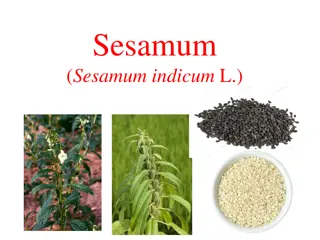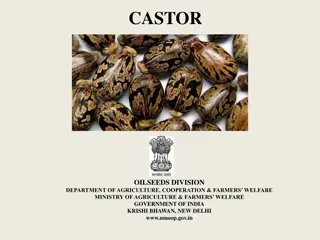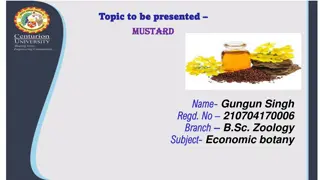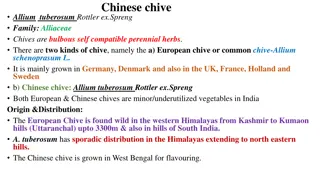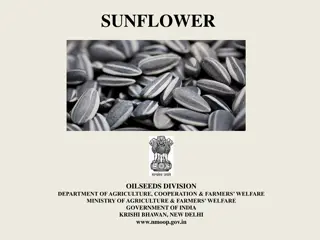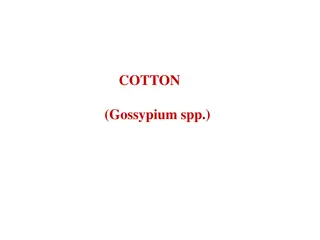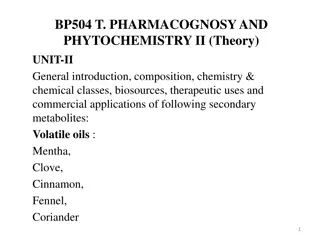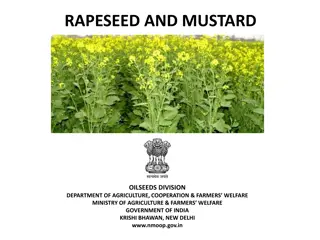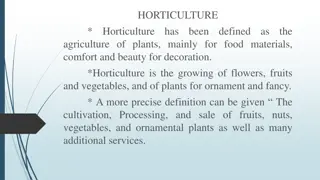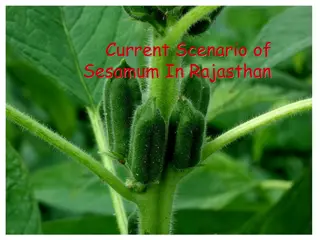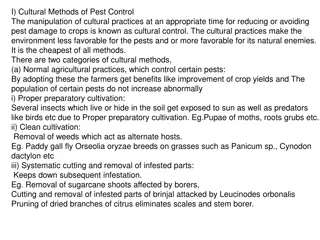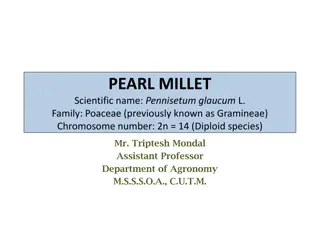Overview of Sesame Cultivation in India: Insights and Statistics
Sesame cultivation in India is a significant agricultural activity, with key information on its botanical description, suitable seasons and climates, global versus national scenarios, major growing states' statistics, and yield gaps. India ranks high globally in sesame production, with specific focus on key states like West Bengal, Rajasthan, and Uttar Pradesh. The data highlights average area, production, and yield figures, showcasing the prominence and potential of sesame farming in the country.
Download Presentation

Please find below an Image/Link to download the presentation.
The content on the website is provided AS IS for your information and personal use only. It may not be sold, licensed, or shared on other websites without obtaining consent from the author. Download presentation by click this link. If you encounter any issues during the download, it is possible that the publisher has removed the file from their server.
E N D
Presentation Transcript
SESAME OILSEEDS DIVISION DEPARTMENT OF AGRICULTURE, COOPERATION & FARMERS WELFARE MINISTRY OF AGRICULTURE & FARMERS WELFARE GOVERNMENT OF INDIA KRISHI BHAWAN, NEW DELHI www.nmoop.gov.in
BOTANICAL DESCRIPTION Family : Pedaliaceae Common name : Til, Gingeli Scientific name :Sesamum indicum Origin : Probably of African origin
SEASON AND CLIMATE Season:Kharif in arid and semi-arid tropics and rabi/summer incooler areas Climate : Semi arid climate of Western India, Central, Eastern and Southern part of India including lower Himalayas
GLOBAL SCENARIO Area (lakh ha) in major sesame growing countries India 18.93 Myanmar Nigeria 34.1 11.11 China Ethiopia 5.29 2.1 4.53 3.20 Uganda Others
GLOBAL vs NATIONAL SCENARIO Highest yield (China) : 1234 kg/ha World average yield : 535 kg/ha Indian average yield : 413 kg/ha More than 85% production of sesame comes from West Bengal, Rajasthan, Uttar Pradesh, Gujarat, Andhra Pradesh and Telangana Madhya Pradesh,
AVERAGE AREA, PRODUCTION AND YIELD OF MAJOR SESAME GROWING STATES (2013-14 TO 2015-16) State Area (lakh ha) Production (lakh tonnes) 0.20 0.90 0.65 0.97 0.22 1.74 0.60 0.55 0.99 0.35 0.83 0.91 2.11 8.02 Yield (kg/ha) Andhra Pradesh Assam Chhattisgarh Gujarat Karnataka Madhya Pradesh Maharashtra Odisha Rajasthan Tamil Nadu Telangana Uttar Pradesh West Bengal All India 0.61 0.12 0.18 1.94 0.45 3.30 0.28 0.23 3.52 0.56 0.26 3.87 2.22 17.90 321 746 360 493 500 528 199 237 285 621 313 215 951 448
AVERAGE AREA, PRODUCTION AND YIELD OF SESAME IN INDIA DURING 2013-14 TO 2015-16 25.00 Area (lakh ha) 20.00 15.00 Productionj (lakh tonne) 10.00 Yield (q/ha) 5.00 0.00 2013-14 2014-15 2015-16 Average
YIELD GAP IN SESAME FLDs on sesame organized during 2013-14 showed an average yield gap of 84% over national average yield Yield gap over state average yield was 58- 209% West Bengal is the largest producer of sesame and has the highest state average yield of 939 kg/ha
POTENTIAL STATES AND DISTRICTS 1. Uttar Pradesh District Avg. area 2011-2012 to 2013-14 (`000 ha) 89.53 37.97 35.33 28.80 20.47 16.33 11.80 11.67 9.80 9.70 7.97 5.43 Jhansi Hamirpur Jalaun Mahoba Hardoi Banda Unnao Lalitpur Fatehpur Sitapur Shahjahanpur Sonbhadra
POTENTIAL STATES AND DISTRICTS (contd) 2. Madhya Pradesh District Avg. area 2011-12 to 2013-14 (`000 ha) 74.10 31.33 27.27 14.07 10.93 9.37 8.97 7.60 6.93 6.17 Chhatarpur Panna Datia Gwalior Shivpuri Bhind Sidhi Satna Shahdol Katni
POTENTIAL STATES AND DISTRICTS (contd) 3. Rajasthan District Avg. area 2009-2010 to 2011-12 (`000 ha) Tonk Sawai Madhopur Jodhpur Bhilwara Kota Nagaur Bundi Karauli Ajmer Jaipur Baran Sirohi Dausa 50.92 41.15 36.58 30.22 29.76 24.94 24.13 23.80 22.75 19.50 18.00 15.87 13.18
POTENTIAL STATES AND DISTRICTS (contd) 4. Gujarat District Avg. area 2010-11 to 2012-13 (`000 ha) Surendranagar Kutch Junagadh Jamnagar Bhavnagar Banaskantha Amreli Mehsana 40.40 34.80 22.37 20.70 18.97 16.20 13.87 6.30
POTENTIAL STATES AND DISTRICTS (contd) 5. West Bengal District Avg. area 2011-2012 to 2013-14 (`000 ha) 27.38 19.28 17.68 13.75 9.17 5.19 -- Nadia Bankura Murshidabad Bardhaman North 24 Paragans Birbhum Paschim Medinipur* *Although Paschim Medinipur had the highest area (6.03 lakh ha) during 2009-10, data for the period is not available
POTENTIAL STATES AND DISTRICTS (contd) 6. Andhra Pradesh Districts Avg. area 2010-11 to 2012-13 (`000 ha) Vizianagaram 16.23 Karimnagar 6.67 Visakhapatnam 6.50 Srikakulam 6.23 YSR Kadapa 5.10 SPSR Nellore 5.10
POTENTIAL STATES AND DISTRICTS (contd) 7. Maharashtra District Avg. area 2008-2009 to 2010-11 (`000 ha) Jalgaon 13.50 Dhule 4.43 Latur 4.23 Osmanabad 4.10 Parbhani 3.53 Beed 3.20
POTENTIAL STATES AND DISTRICTS (contd) 8. Karnataka District Avg. area 2011-12 to 2013-14 (`000 ha) Mysore 7.13 Gulbarga 5.57 Mandya 5.37 Koppal 4.23 Bidar 3.00
CROPPING SYSTEMS Crop Sequence State Andhra Pradesh Rice-Groundnut-Sesame, Sesame - Horsegram, Finger millet/Sorghum/Horsegram Sesame - Upland Rice - Sesame, Bihar Early Rice - Potato-Summer Sesame/Green gram, Kharif Sesame-Maize/Pigeonpea/Chickpea, Wheat- Summer Sesame/Green gram Gujarat Sesame-Wheat/Mustard Karnataka Sesame-Horsegram/Chickpea Madhya Pradesh Cotton-Sesame-Wheat, Rice -Summer Sesame, Sesame-Wheat
CROPPING SYSTEMS States Crop Sequence (Early)-Rabi Maharashtra Sesame Cotton-Sesame-Wheat Rice/Potato-Sesame, Maize/Pigeonpea/Chickpea Sesame-Wheat/Green gram/Barley Rice/Groundnut-Sesame, Sesame-Black gram, Sesame-Rabi Sorghum, Sesame-Green gram, Cowpea-Sesame Sorghum/Safflower, kharif Odisha Sesame- Rajasthan Tamil Nadu Uttar Pradesh Sesame Mustard/Lentil/Pea Potato-Sesame (Late Jan./Early Feb), Rice Sesame (Early)-Chickpea/Rapeseed & West Bengal
STATEWISE INTER-CROPPING State Intercropping System Gujarat Sesame+Groundnut / Urd bean (3:3) Sesame+Pearlmillet / Cotton (3:1) Karnataka Madhya Pradesh Sesame+Groundnut (1:4) Sesame+Green gram / Black gram (2:2 or 3:3) Sesame+Soybean (2:1 or 2:2) Maharastra Odisha Sesame+Pearlmillet / Black gram (3:1) Sesame+ Summer Groundnut (2:3) Sesame+Green gram/Black gram (2:2) Rajasthan Tamil Nadu Sesame+Pearlmillet / Mothbean (1:1) Sesame+Green gram / Black gram (3:3) Sesame+Pigeonpea (3:1), Sesame+Groundnut (2:4) Uttar Pradesh West Bengal Sesame+Green gram (1:1), Sesame+ Pigeonpea (3:1) Sesame+ Groundnut (1:3 or 2:2)
VARIETIES State Variety Seed Colour White seed Black seed White seed Gujarat Guj. Til-1, 2, 3 Guj. Til-10 TKG-21, 22, 55, 306, 308 and JTS 8 Madhya Pradesh PKDS-11, 12 Dark brown seed PKDS-8 RT-46, 103, 346, 351 RT-54 AKT-64 , AKT-101, JLT-408, PKVNT-11 Bold black seeded White seed Rajasthan 125, 127, Light brown seed White seed Maharashtra Uttar Pradesh T-78, Sekhar White seed
VARIETIES Variety TSS-6 Co-1, Paiyur-1, VRI-1, VRI-2, TMV-7 State Seed Colour White seed Black and Brown seed Tamil Nadu West Bengal Odisha Rama, Savitri Nirmala, Shubhra Prachi, Amrit Smarak Brown seed White seed Brown / Black seed Golden yellow and bold seed Brown seed Andhra Pradesh Varaha, Gautama, Chandana Swetha Til, Hima DS-1 DSS-9 White seed Dark brown seed White bold seed Karnataka
PACKAGE AND PRACTICES Soil: Sesame can be grown on a wide range of soils but well drained light to medium textured soils are preferred. The optimum pH range is 5.5 to 8.0, acidic or alkaline soils are not suitable Seed rate: A seed rate of 5 kg/ha is adequate to achieve the required plant population Sowing method: To facilitate easy seeding and even distribution seed is mixed with either sand or dry soil or well sieved farm yard manure in 1:20 ratio
PACKAGE AND PRACTICES (contd) Sowing Time and Spacing: State Season Sowing time Spacing (cm) Kharif Summer Andhra Pradesh/ Coastal Telangana Second fortnight of May Second fortnight January Second fortnight of July 30 x 15 30 x 15 of Kharif 30 x 10-15 Kharif Assam July-August 30 x 10-15 Kharif Bihar/ Jharkhand July 30 x 15
PACKAGE AND PRACTICES (contd) Sowing Time and Spacing: State Gujarat Kharif Season Sowing time Last week of June to second fortnight of July Mid September January-February Spacing (cm) 45 x 10 Semi-rabi Summer 45 x 10 45 x 15 Karnataka North South Kharif Early Kharif June-July April-May 30 x 15 30 x 15 Kharif Summer Kerala August December 30 x 10-15 30 x 15
PACKAGE AND PRACTICES (contd) Sowing Time and Spacing: State Season Madhya Pradesh /Chhattisgarh Summer Second to last week of February Maharashtra Kharif Second fortnight of June to July Early September February Odisha Kharif Rabi Summer February Sowing time First week of July Late August-Early September Spacing (cm) 30 x 10-15 30 x 15 Kharif Semi-rabi 30 x 15 30 x 15 Semi-rabi Summer 30 x 15 45 x 15 30 x 15 30 x 15 30 x 15 June-July September-October
PACKAGE AND PRACTICES (contd) Sowing Time and Spacing: State Season Punjab/ Haryana Rajasthan Kharif Late June-Early July Tamil Nadu Kharif Second fortnight of May to Second fortnight of June November-December Second January to March Uttar Pradesh & Uttarakhand West Bengal Summer February-March Sowing Time Second fortnight of July Spacing (cm) 30 x 10-15 Kharif 30 x 15 22.5 x 22.5 Rabi Summer 22.5 x 22.5 30 x 10 fortnight of Kharif Second fortnight of July 30-45 x 15 30 x 15
PACKAGE AND PRACTICES (contd) Seed Treatment: For prevention of seed borne diseases, use seed treated with Bavistin 2.0 g/kg seed Wherever bacterial leaf spot disease is a problem, soak the seed for 30 minutes in 0.025% solution of Agrimycin-100 prior to seeding
PACKAGE AND PRACTICES (contd) Manure and Fertilizer: State/ Situation Recommended dose of N:P:K (kg/ha) Andhra Pradesh Coastal region Telangana 30-30-20 Gujarat Kharif Semi-rabi 25-25-0 37.5-25-25 Specific recommendation - 40-40-20 30-25-0 Apply sulphur @ 20-40 kg/ha. Half N + full P2O5 and K2O as basal, remaining half N at 30-35 DAS. Madhya Pradesh /Chhattisgarh Rainfed Summer 40-30-20 60-40-20 Apply 25 kg/ha zinc sulphate once in three years in zinc deficient soils.
PACKAGE AND PRACTICES (contd) Manure and Fertilizer: State/ Situation Recommended dose of N:P:K (kg/ha) Specific recommendation Maharashtra 50-0-0 Half N at 3 weeks after sowing and remaining half 6 weeks thereafter Odisha 30-20-30 - Rajasthan Heavy soils 20-20-0 For areas with less than 350 mm rainfall For areas with more than 350mm rainfall Light soils 40-25-0
PACKAGE AND PRACTICES (contd) Manure and Fertilizer: State/ Situation Recommended dose of N:P:K (kg/ha) Specific recommendation Tamil Nadu Irrigated 35-23-23 Apply full dose of N, P2O5, K2O as basal. Seed may be treated with Azospirillum. - Rainfed 25-15-15 Uttar Pradesh /Uttarakhand West Bengal Irrigated Rainfed 20-10-0 50-25-25 25-13-13 No fertilizer if sown after potato.
PACKAGE AND PRACTICES (contd) Weeding and Inter-culture: The crop is very sensitive to weed competition during the first 20-25 days. Two weeding, one after 15-20 days of sowing and other at 30-35 days after sowing are required to keep the field weed free and to make moisture and nutrients available to the crop Irrigation: For good seed filling and yield, irrigations at flower initiation and capsule formation are essentially required
PACKAGE AND PRACTICES (contd) Crop Protection: Insect Nature of damage crop is damaged Leaf Roller and Capsule Borer (Antigastra catalaunalis Dup.) and remain inside the leaf web. Stage when Period of pest activity July September Integrated management In early stage of caterpillars feed tender leaves The attack of the pest when the crop is about 15 days old. first to Crop rotation is effective in reducing pest population. Birds eat the Caterpillars. Apply Phorate 10 G@10 kg a.i. /ha as basal application. Two sprays of Endosulfan 0.07% or Monocrotophos 0.05% or 0.05%, at 30 and 45 days after sowing. Two rounds of dusting with Phosalone 4%, Malathion 5% Endosulfan 4% dusts 25 kg/ha at 30 and 45 days after sowing. crop, starts on Quinalphos
PACKAGE AND PRACTICES (contd) Crop Protection: Insect Nature of damage Maggots inside the floral bud leading formation of gall like structure and do not into capsule. Maggots inside the floral bud leading formation of gall like structure. Stage when crop is damaged At the time of bud initiation Period of pest activity Sept. to Nov. Integrated management Spray crop at bud initiation stage Dimethoate 0.03% Endosulfan 0.07%. Gall Fly (Asphondylia sesami Folt.) feed to with or develop flower/ Bud Fly (Dasynura sesami G&P) feed At the time of bud initiation Sept to Oct As in the case of gall fly. Use varieties MT-75 Shekhar. As in the case of gall fly. to tolerant like and Sesame Leaf Hopper (Orosius Nymph & adults suck sap of tender parts of plants. From vegetative to capsule stage July to end of September
PACKAGE AND PRACTICES (contd) Crop Protection: Insect Nature of damage crop is damaged Hawk Moth (Acherontia styx W.) leaves and defoliates the plant Stage when Period of pest activity Integrated management Caterpillars feed Throughout the crop growth August to October Deep ploughing exposes the pupae for birds. Collection and destruction of caterpillars. Two rounds of dusting with Phosalone 4% or Malathion 5% or Endosulfan 4% dust 25 kg/ha, first at 30 DAS and second at 45 DAS. Spray at the bud initiation stage with Dimethoate (0.03%) or Endosulfan (0.07%). Dusting with Phosalone 4%, Malathion 5% or Endosulfan 4% @ 25 kg/ha at 30 & 45 DAS. on the Bihar Caterpillar (Spilosoma obliqua) Hairy At early stages, larvae gregarious feeders Starting from vegetative stage maturity August October to are till
PACKAGE AND PRACTICES (contd) Crop Protection: Disease Symptoms Stage of crop when disease appears Seedling to flowering stage. Integrated management Phytophthora Blight (Phytophthora nicotianae var. parasitica f. sp. sesami) Initially soaked appear on leaves & stem. The spots brown beginning turn to black. In humid weather severity of disease increases & causes death plant with blighted appearance. water spots Summer deep ploughing. Improve drainage. Two years crop rotation. Use disease free seed. Intercropping, sesame + pearl millet (3:1) Use tolerant varieties viz. TKG-21, TKG-22, TKG-55, JTS-8, AKT-64. in the Seed treatment before sowing with approx 35SD (0.3%) or Ridomil MZ (0.25%) Trichoderma harzianum or T. viride or Bacillus subtilis (0.4%). Spray three times with Ridomil MZ (0.25%) or Copper oxychloride (0.25%) at an interval of 10 days from the initiation of disease. of
PACKAGE AND PRACTICES (contd) Crop Protection: Disease Symptoms Stage of crop when disease appears Stem and Root Rot (Macrophomina phaseolina/ Rhizoctonia bataticola) Integrated management Disease appears on root and stem. The affected plants show wilting. Seedling to maturity Two years crop rotation. Summer deep ploughing. Use disease free seed. Follow intercropping sesame + mothbean 1:1 or 2:1 ratio. Use tolerant varieties viz. RT-46, RT-54, RT-103, RT-125, RT-127, TKG-55, JTS-8, MT-75, Nirmala. Treat the seed with T. viride or T. harzianum or (0.4%) or Thiram 75 SD (0.2%) + Bavistin (0.1%) or Thiram 75 SD (0.3%). Uproot and destroy the infected plants. Irrigate field to condition. Bacillus subtilis avoid stress
PACKAGE AND PRACTICES (contd) Crop Protection: Disease Symptoms Stage of crop when appears Spots from 4-leaf stage of the crop and continue maturity. Integrated management disease Bacterial Blight (Xanthomonas campestris pv. sesami) Water small and irregular spots are formed on the which increase in number and turn brown, under favourable conditions. soaked, appear Seed treatment with hot water at 520C for 10 min. Foliar spray of Streptocycline or Plantomycin (500ppm) as soon as symptoms noticed. Continue 2 more sprays at 15 days interval if necessary. Destruction weed Acanthospermum hispidum leaves, later till are of Bacterial Leaf Spot (Pseudomonas syringae pv. sesami) Small angular light brown to brown spots confined to veins with dark margins. From 4-6 leaf stage of crop. As in case of Bacterial Blight.
PACKAGE AND PRACTICES (contd) Crop Protection: Disease Symptoms Stage of crop when disease appears Cercospora Leaf Spot (Cercospora sesami, C. sesamicola) with gray center & dark margin delimited by veins. Integrated management Disease as small, angular brown leaf spots of 3 mm diameter appears 4-6 leaf stage of the crop continues maturity. Early planting i.e. immediately after onset of monsoon. Follow intercropping of Sesame + Pearlmillet (3:1). Treat the seed with Thiram (0.2%) + Bavistin (0.1%). Use resistant variety TKG-21. Three sprays of Dithane M-45 (0.25%) or Topsin M (0.1%) at 15 days interval. Use tolerant varieties viz. TC-25, RT-46, RT-54, JTS-8, Sekhar, Usha, TSS-6, Nirmala, RT-125. Spray Dithane M-45 (0.2%) at 15 days interval when disease appears. and till Alternaria Leaf (Alternaria sesami) Spots on leaves are circular irregular in shape and often have concentric rings. Spots appear at about 1 month crop age Spot brown to
PACKAGE AND PRACTICES (contd) Crop Protection: Disease Symptoms Stage of crop when disease appears Powdery Mildew (Oidium sp, Sphaerotheca sp., Leveillula sp.) Integrated management Small spot appears on the leaves. cottony 45 maturity. days to Early planting i.e. immediately after onset of monsoon. Use resistant varieties viz. Swetha, RT-127, MT-75. Foliar spray (2-3 times) of wettable sulphur (0.2%) or Bavistin (0.1%) or Tilt (0.1%) at 10 days interval. Rogue out diseased plants. Use intercropping, pigeonpea (1:1). Use tolerant varieties viz. JT-21, Swetha, Rama, Shekhar. Soil application of Phorate 10 G @ 5 kg/ha. Three sprays of Dimethoate (0.3%) at 30, 40 and 60 days after sowing. infected Phyllody (Phytoplasma) All floral parts are transformed into green leafy structures. Such plants generally do not capsules. Flowering stage. sesame + bear
HARVESTING AND THRESHING The best time of harvesting is when the leaves turn yellow and start drooping and the bottom capsules are lemon yellow Delay in harvesting may result in shattering
NUTRITIVE VALUE According to Hindu mythology and beliefs, sesame seeds and oil are considered as symbol of immortality and most auspicious Sesame seeds are a very good source of copper, magnesium and calcium Sesame flour has high protein, high levels of methionine and tryptophan, essential amino acids Sesame oil is considered to be one of the most healthy cooking oils due to rich source of oleic (40-50%) and linoleic (35-45%) fatty acids Sesame seeds are used in large number of confectionary products and sweets in nutraceutical and pharmaceutical uses addition to industrial,
MARKETING & EXPORT Sesame is covered under Minimum Support Price (MSP) scheme of the Government Among oilseeds, sesame occupies 2nd position after groundnut as far as exports of oilseeds are concerned More than 40% of the sesame seeds produced in India are exported every year The export price of Rs. 125.47 per kg as against the MSP of Rs. 46.00 per kg during 2014-15 indicates vast difference between the domestic price fixed by the government and export price
SEED PRODUCTION, EXPORT AND IMPORT Prod- uction (lakh tonnes) tonnes) crore) kg) Year Export Import MSP (Rs/kg) Quantity (lakh Value (Rs. in Price (Rs/ Quantity (lakh tonnes) Value (Rs. in crore) Price (Rs/kg) 2012-13 6.85 2.99 2880.85 96.35 0.014 4.18 298.60 42.00 2013-14 7.15 2.57 3583.46 139.43 0.011 3.76 341.82 45.00 2014-15 8.28 3.76 4717.77 125.47 0.012 4.01 334.17 46.00 Total 22.28 9.32 11182.08 - 0.037 11.95 -
RESEARCHABLE ISSUES Evolving varieties with high seed yield and oil content coupled with resistance to biotic and abiotic stresses Development of bold white seeded varieties with low anti-nutritional factors (oxalic/phytic acid) Development of sesame hybrid Development of short duration varieties for Rabi/Summer seasons for rice fallows Development of package of practices for organic sesame Development of IPM modules for diseases and insect pests
ISSUES / ACTIONABLE POINTS ICAR/SAUs may develop varieties with high seed yield and oil content having resistance to biotic and abiotic streses with low anti nutritional factor Development of hybrids and short duration verities for rice fallow areas with organic package by ICAR/SAUs Rajasthan, Uttar Pradesh, Gujarat and Madhya Pradesh which have high area coverage but low productivity may make productivity Sesame growing States may bridge the yield gap which has been found up to 200% Focused efforts for higher export of white seeded organic sesame with better nutritive value and assured procurement efforts for improving


